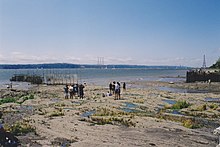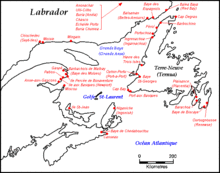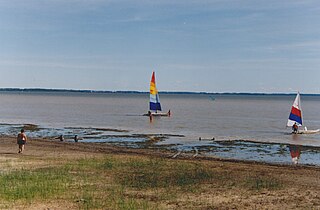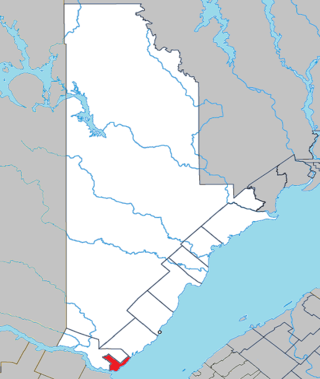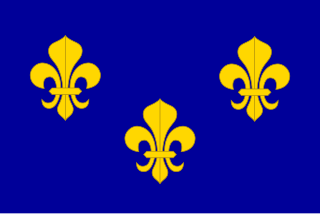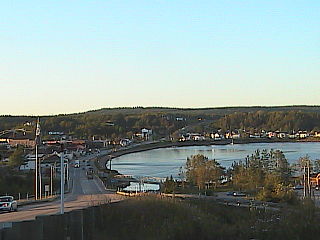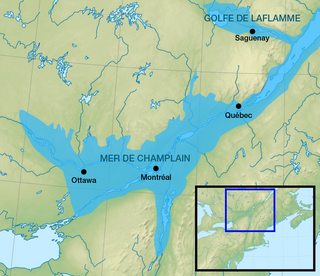| St. Lawrence River Saint Lawrence River | |
|---|---|
 | |
 Great Lakes/St. Lawrence watershed | |
| Etymology | Saint Lawrence of Rome |
| Location | |
| Country | Canada, United States |
| Provinces | Ontario, Quebec |
| State | New York |
| Physical characteristics | |
| Source | Lake Ontario |
| • location | Kingston, Ontario / Cape Vincent, New York |
| • coordinates | 44°06′N76°24′W / 44.100°N 76.400°W |
| • elevation | 74.7 m (245 ft) |
| Mouth | Gulf of St. Lawrence / Atlantic Ocean |
• location | Quebec, Canada |
• coordinates | 49°30′N64°30′W / 49.500°N 64.500°W |
• elevation | 0 m (0 ft) |
| Length | 500 km (310 mi) excluding the estuary. C. 928 km if included. (St. Lawrence River–Lake Ontario–Niagara–Lake Erie–Detroit–Lake St. Clair–St. Clair–Lake Huron–St. Marys River–Lake Superior–St. Louis–North River: 3,058 km) [1] [2] |
| Basin size | 1,344,200 km2 (519,000 sq mi) [3] (Pointe-des-Monts: 1,271,547.4 km2) [4] |
| Width | |
| • average | 1–5 km (0.62–3.11 mi) [5] |
| Depth | |
| • minimum | 2 m (6 ft 7 in) (Fluvial Section) [5] |
| • maximum | 60 m (200 ft) (Quebec City) [5] |
| Discharge | |
| • location | Pointe-des-Monts |
| • average | (Period: 1969–2023)17,600 m3/s (620,000 cu ft/s) [6] |
| • minimum | 10,478 m3/s (370,000 cu ft/s) [6] |
| • maximum | 33,085 m3/s (1,168,400 cu ft/s) [6] |
| Discharge | |
| • location | Tadoussac |
| • average | (Period: 1962–1988)16,800 m3/s (590,000 cu ft/s) [7] |
| Discharge | |
| • location | Quebec City |
| • average | (Period: 1968–2023)12,500 m3/s (440,000 cu ft/s) [6] |
| • minimum | 8,600 m3/s (300,000 cu ft/s) [6] |
| • maximum | 22,766 m3/s (804,000 cu ft/s) [6] |
| Discharge | |
| • location | Montreal |
| • average | (Period: 1971–2000)10,063.3 m3/s (355,380 cu ft/s) [4] |
| Discharge | |
| • location | Cornwall |
| • average | (1861–2019)7,060 m3/s (249,000 cu ft/s) [6] |
| Basin features | |
| Progression | Gulf of St. Lawrence |
| River system | St. Lawrence River |
The St. Lawrence River (French : Fleuve Saint-Laurent) is a large international river in the middle latitudes of North America connecting the Great Lakes to the North Atlantic Ocean. Its waters flow in a northeasterly direction from Lake Ontario to the Gulf of St. Lawrence, traversing Ontario and Quebec in Canada and New York in the United States. A section of the river demarcates the Canada–U.S. border.
Contents
- Etymology
- Geography
- Marine weather
- Watershed
- Sources
- Tributaries
- Discharge
- Biodiversity
- Marine mammals
- History
- First Nations
- European exploration
- Early colonists
- Colonial control
- Modern Canada
- In popular culture
- See also
- References
- Bibliography
- External links
As the primary drainage outflow of the Great Lakes Basin, the St. Lawrence has the second-highest discharge of any river in North America (after the Mississippi River) and the 16th-highest in the world. The estuary of St. Lawrence is often cited by scientists as the largest in the world. Significant natural landmarks of the river and estuary include the 1,864 river islands of the Thousand Islands, the endangered whales of Saguenay–St. Lawrence Marine Park, and the limestone monoliths of the Mingan Archipelago.
Long a transportation route to Indigenous peoples, the St. Lawrence River has played a key role in the history of Canada and in the development of cities such as Montreal and Quebec City. The river remains an important shipping route as the backbone of the St. Lawrence Seaway, a lock and canal system that enables world marine traffic to access the inland ports of the Great Lakes Waterway.
